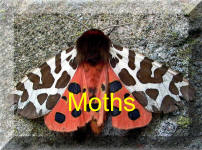
Family Sphingidae : Macroglossinae
Wingspan 40-50 mm.
Flight period April to December
Description
This moth is an annual immigrant to our shores from April to December, but is usually only seen inlimited numbers around the south coast, although outbuildings. Non the less a large influx occurred in the summer of 2000, when moths were observed in parks and gardens all over The Humming Bird Moth flies in the daytime sunshine hovering over flowers, using its long tongue to sip the nectar like its avian counterpart feeding on tubular flowers of plants such as viper’s bugloss, red valerian, jasmine, petunia and other garden plants such as geranium, buddleia.Orange-brown hindwings and black and white chequered body can be seen in flight and, withgreyish-brown forewings just visible Bee Hawk-moths will fly in a similar manner.
Larvae feed on bedstraw (Galium), and some of these may hatch giving rise to autumn adults in an influx year. The caterpillars feed on lady’s bedstraw and heath bedstraw and aredistinguished by a ‘horn’ on the end of the green body, in this case bluish. which characterises it as a hawk-moth caterpillar, it also is green with yellow stripes down the side turning brown with age. The Larvae or caterpillar will pupate in a cocoon low in the vegetation or in leaf litter, and the adults emerge late in the autumn. Few caterpillars will make it because of low temperatures.
Other Imigrants
Other imigrants Silver Y Autographa gamma and Rusty-dot Pearl Udea ferrugalis and the
Convolvulus Hawk-moth Agrius convolvuli,The Cosmopolitan Mythimna loreyi
